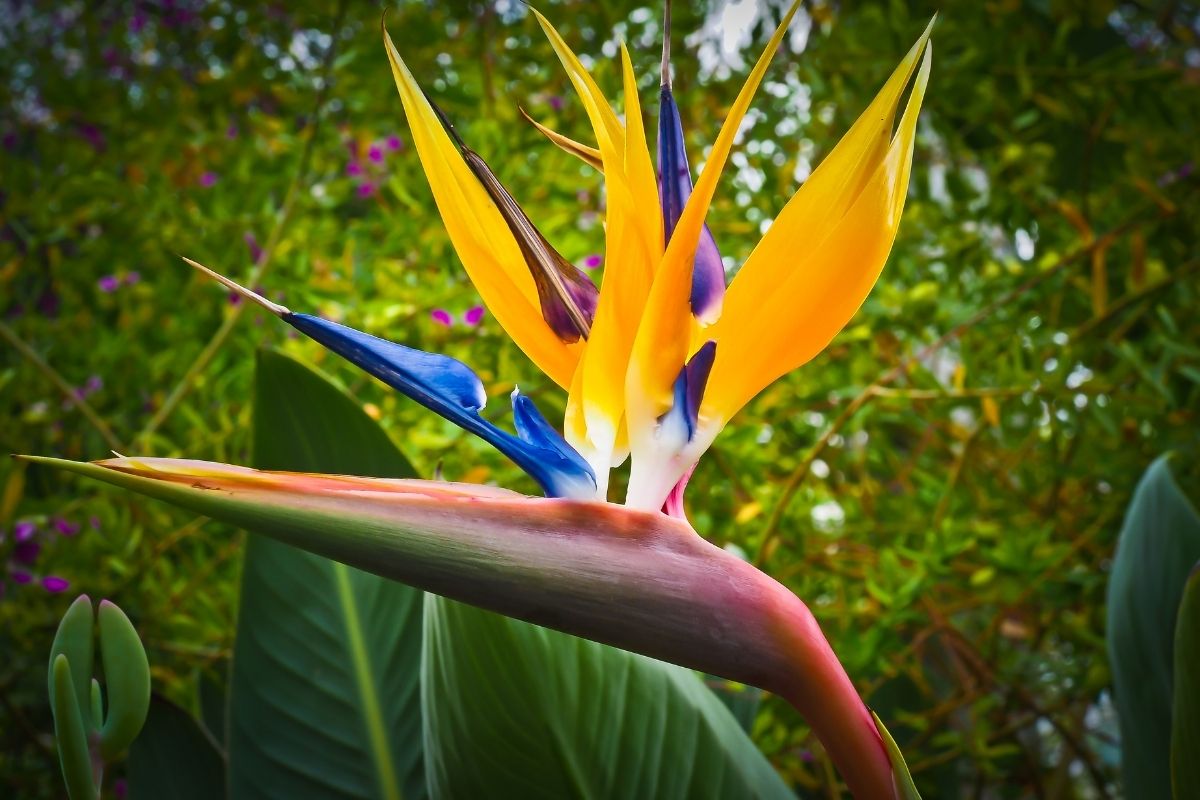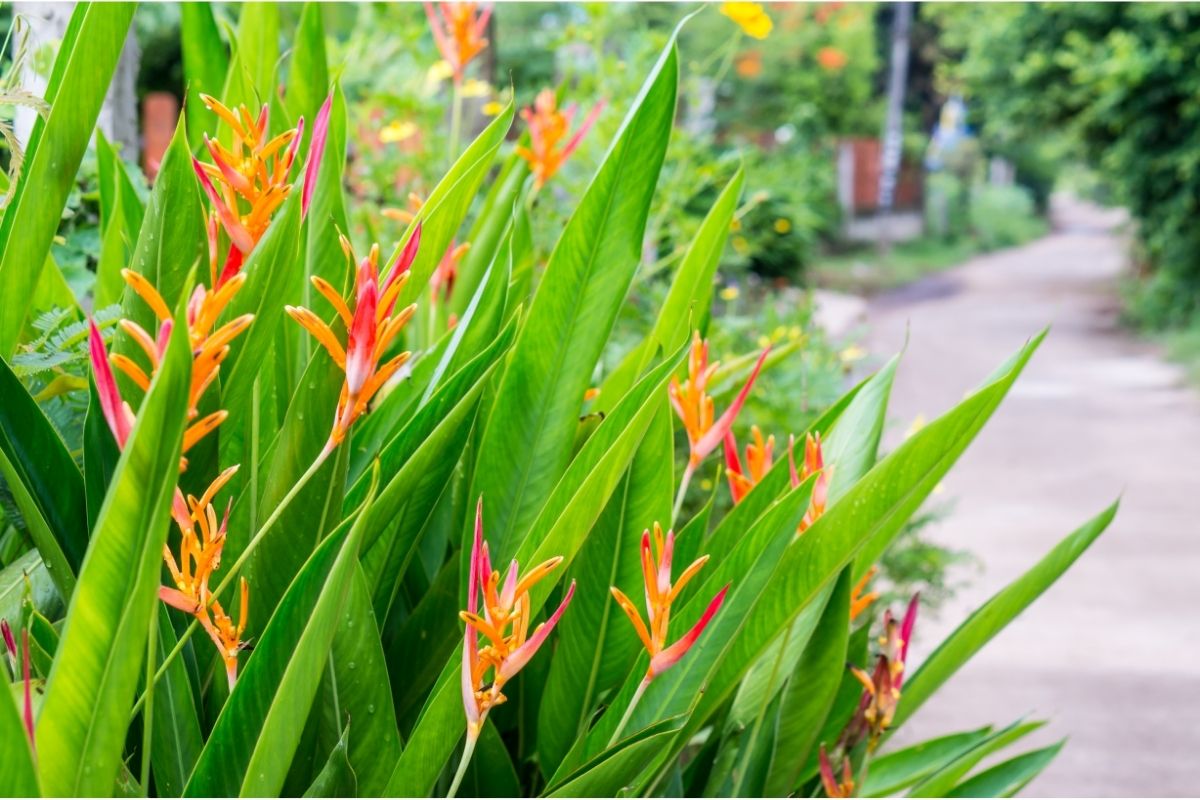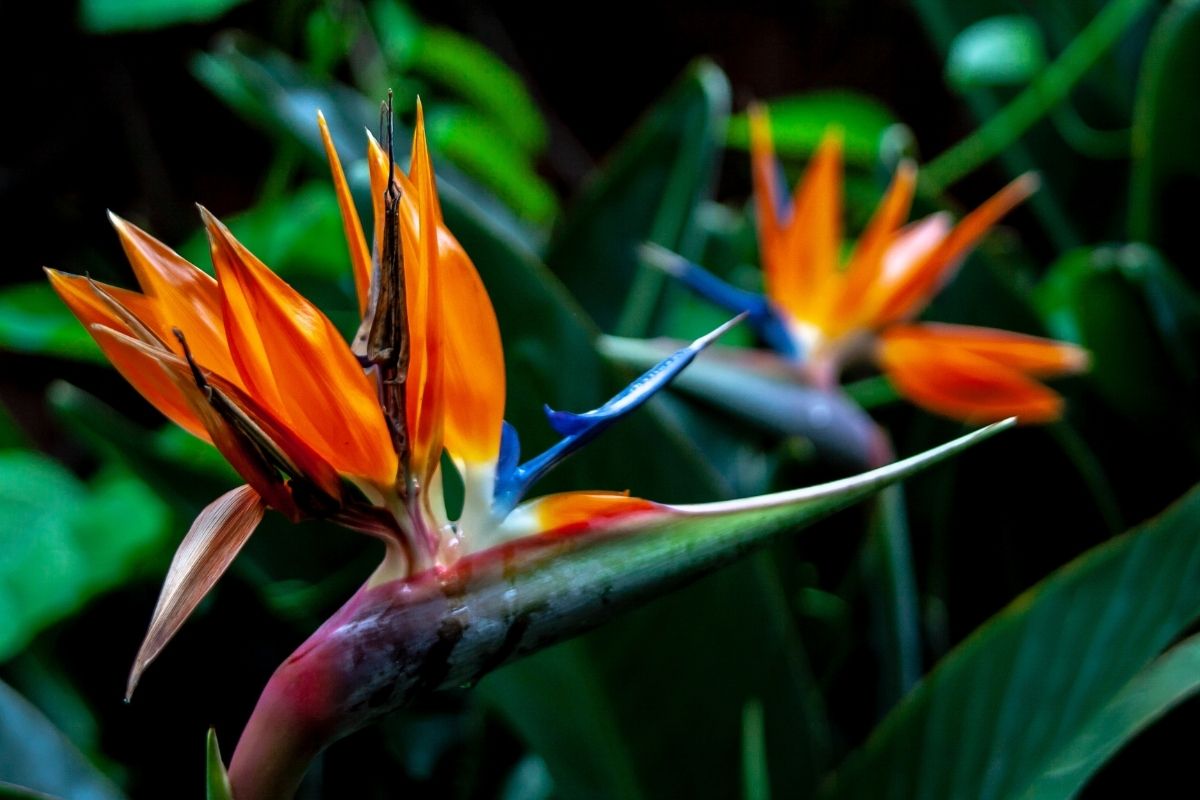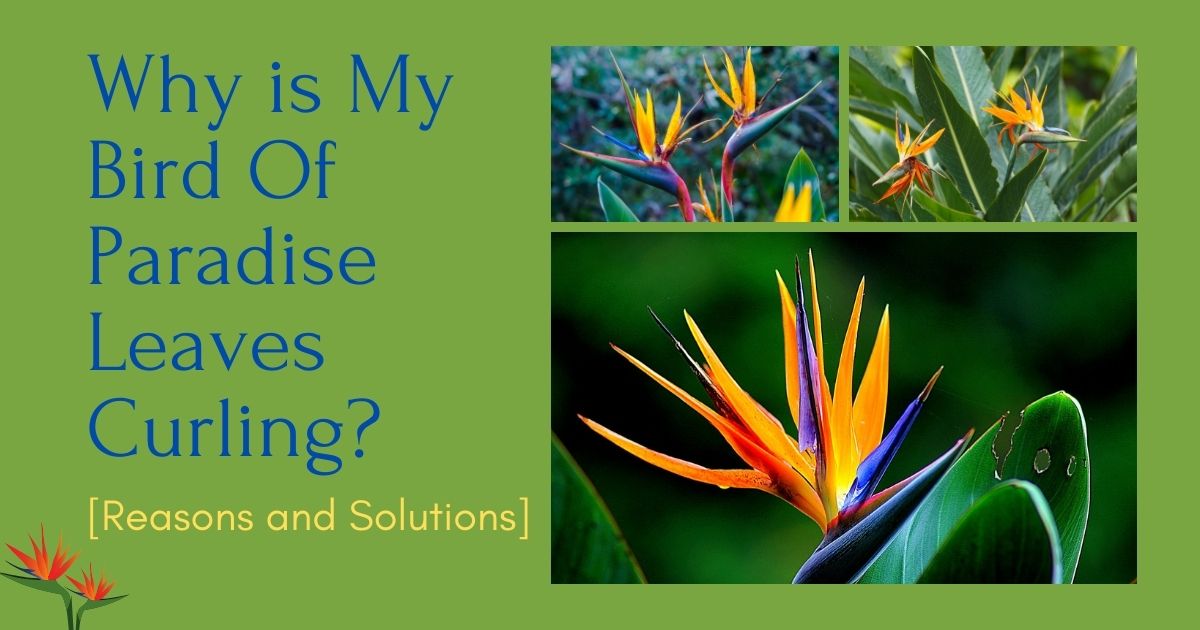What is a Bird of Paradise?
A bird of paradise is a flower with massive leaves and orange blossoms that resemble a tropical bird. You may have heard of people talking of bird of paradise leaves curling. In this article, you will learn why the bird of paradise leaf curls together with the solutions. Read on to find out:
What Does a Bird of Paradise Look Like?
The bird of paradise plant is one of the common plants on the planet. It is native to southern Africa’s subtropical coastal areas, and people farm it worldwide. It has become naturalized in North, Central, and South America and Portugal, where it is the national flower.
Horticulturists, designers, florists, and gardeners love it because of its exotic appearance, which has distinctive and brightly colored blossoms that resemble a bird’s head. A bird of paradise in full bloom resembles numerous birds hiding in a cluster of foliage, craning their necks and rotating their plumed heads and pointed beaks in various directions.

Why is my Bird of Paradise Leaves Curling?
The bird of paradise is an otherworldly plant that combines fantasy with spectacle. This plant stands out in the landscape due to its dazzling inflorescence, eerie similarity to its namesake, and towering enormous leaves. You can see curling bird of paradise leaves in adverse locations and situations. Birds of paradise leaves curling could be because of several factors.
Here are a few to assist you to figure out why the leaves of the bird of paradise curl:
Underwatering
Dehydration is one of the leading causes of bird of paradise leaves curling. Because of its large leaves, this plant loses a tremendous amount of moisture each day. It will curl inward if you don’t give it enough water.
All plants reduce their leaf area, lowering the amount of moisture they evaporate. Dry leaves at the leaf tips and edges are another indication. To repair the situation and avoid something like this from happening again, you must adequately hydrate the bird of paradise. It’s time to water if the soil in the pot is more than half dry.
Water the plant thoroughly until the soil in the pot is saturated. Use pots with drainage holes. The extra water from the watering will drain via the drainage holes. However, do not leave any dripping water on the saucer beneath the pot, as this might be detrimental to the plant’s health.
You should also water the bird of paradise with water sitting for a few days. The chlorine in the tap water should dissipate within a few minutes. The presence of this element in water has the potential to be harmful.
Low Relative Humidity
You may notice a bird of paradise plant with curled leaves in dry air. Heating in the winter or proximity to an air conditioner in the summer can cause humidity deficiency. Large dry patches on the leaves are another indication. Keep bird of paradise away from heaters and other equipment that produce heat or intense air movement to avoid this.
The second step is to mist the leaves once or twice a week, but not more frequently, as this can cause fungal patches on the leaves. You can also put stones in a container and fill them halfway with water. The water will slowly evaporate in this situation, generating the ideal environment around the plant.
Too Much Sun
Birds of paradise leaves curling might happen if exposed to too much light. This plant, in general, requires many hours of direct sunlight per day. A rapid change in sun exposure might cause burns and curling if it continuously grows in the diffuse sun.
To solve this issue, you must locate the ideal location for your plant. The best option is to put it in front of an east or west window and gradually increase the quantity of light. You’ll know just how much sunlight your bird of paradise can withstand this way. A slight increase in the amount of water used when watering can also help the plant recover faster.
Temperature-Related Stress
Because the bird of paradise is not a hardy plant, many people grow it as an indoor plant. However, owners frequently move the bird of paradise outside during the summer for better development. Nighttime cold episodes are common in the summer, causing the leaves to curl and even turn crimson.
Another example would be when you turn on the heat in the cold. Dry and hot air can also cause temperature stress. Move the plant to a warmer place and provide shelter from the searing afternoon sun to help it tolerate temperature changes. Increase watering by a small amount.
Owners of birds of paradise fail to repot them into larger pots for several years. As a result, the plant’s above-ground portion becomes enormous while the underground part remains little.
Small Root System
The limited root system does not allow the plant to meet the water and nutritional requirements. Curling of the leaves and signs such as dryness and yellowing of the leaves result. The first step is to transplant the bird of paradise onto a larger container.
For the next one to two years, the new container should be large enough to keep the roots from becoming entangled. After two years, perform the subsequent transplant.
Birds of paradise may experience transplant shock after transplanting. This is another cause of twisted leaves. Avoid this by placing the plant in the shade for a short while and watering it more frequently.
Soil
The poor quality of the soil is the next issue. The soil is frequently undernourished or poorly drained. The leaves may curl as a result of this.
The alkaline nature of the soil is the second issue. Chlorosis arises due to the plants’ inability to obtain all necessary microelements in such soil. A bird of paradise leaves curling and turning yellow is a sign of chlorosis.
Plant your bird of paradise in a loose substrate with lots of compost to ensure it does not suffer from nutrient deficiency. The compost will improve the soil’s fertility, but it will also slightly acidify it. Once a year, you can fertilize your bird of paradise.
For this aim, it is preferable to use a slow-release fertilizer. This will ensure that your plant has all it requires throughout the growing season.
Too Much Watering
One of the most common mistakes when cultivating a bird of paradise is overwatering it. The roots will decay if they submerge in water for an extended period. The leaves will curl outward and turn yellow as the season progresses. The leaves will eventually fall off, and the plant may perish.
Take the bird of paradise out of the container and inspect the roots if you suspect root rot is the reason for the curling leaves. If the roots have rotted, remove them from the soil and wash them. Remove all dead tissue with a sterile tool and apply fungicide to the wounds.
Plant the bird of paradise in a drainage-holed container. The soil must be well-drained and devoid of weeds.
Pests and Diseases
Pests cause curling leaves. First and foremost, it’s the spider mite, a tiny reddish-brown bug. It gets its food by sucking the sap from the plant. The presence of cobwebs on the plant strongly indicates the mite’s existence.
If your bird of paradise has something like this, wash it under running water. Because mites dislike moisture, a shower is generally enough to get rid of them. If the mites persist, you’ll need to spray the plant with an acaricide.
Some insects can also cause the leaves to curl. In this instance, the plant requires horticultural oil or insecticide. Illnesses may also cause twisted leaves. On the leaves, tiny brown patches can also form. You must spray fungicide on the plant to cure it.

Giant Bird of Paradise Care
To care for a bird of paradise, follow these steps that will explain how to water a bird of paradise, as well as its light, temperature, and humidity preferences, as well as any additional care it may require to thrive:
Light
The bird of paradise prefers direct bright light. Although it can adapt to medium light, its growth may slow down. Use a grow light if you don’t have a suitable place for your bird of paradise.
Water
When the top half of the soil is dry, water your bird of paradise. Fill the pot halfway with water and drain any water in the saucer through the drainage hole at the bottom.
Humidity
Your bird of paradise will welcome the misting from time to time, which will also assist in removing dust from its glossy dark foliage. Use our constant automatic Mister to mist your bird of paradise and microfiber dusting gloves to keep it dust-free.
Food
During the spring and summer, use a liquid fertilizer for indoor plants.
Advanced care
Chemicals in your tap water could be causing your plant’s leaves to turn brown at the margins. To allow some of the toxins in tap water to evaporate, use filtered water or put it in an open container overnight before watering. Use clean, sharp plant snips to trim your bird of paradise.
Why is My Bird of Paradise Dying?
Are you wondering, “what is the cause of my bird of paradise’s death?” A dying bird of paradise may happen because of one or more circumstances. Below are the most typical reasons for this.
An Overabundance of Water Suffocates the Root System (Causing Root Rot)
Bird of paradise roots requires normal wet conditions due to their sensitive nature. On the other hand, roots need oxygen to survive and operate effectively.
If you overwater your bird of paradise, the soil will become saturated, inhibiting aeration, weakening the roots, and eventually killing the plant.
Insect Infestation
Among the causes that can cause your bird of paradise to perish, insects are the second most prevalent perpetrator. Unfortunately, when your Strelitzia is weak or the growing conditions aren’t optimum, it is more prone to these pests.
Underwatering
While overwatering is the most prevalent cause of death in birds of paradise, indicators of dehydration should also be kept in mind.
On the other hand, underwatering is easier to spot because it will greet you by a wilting plant. Furthermore, the earth will be crumbly and bone-dry. If you underwater your bird of paradise repeatedly or severely can quickly kill it. Nonetheless, over time, it will undoubtedly result in damaged leaves.
Repotting
These delicate tropical houseplants don’t enjoy having their root systems disrupted. If your plant begins to wilt within a few days of the abrupt transplant, you may need to repot it. This is due to a temporary impairment of your plant’s root system, which results in a lack of water and nutrients.
How to Fix Curling Bird of Paradise Leaves
If you notice your bird of paradise leaves curling, try the following:
- Lack of water can cause curling leaves and overwatering or low humidity when the container is half-dry. Water the bird of paradise.
- The leaves might curl if you expose them to too much sunlight or experience abrupt temperature changes. Determine how many hours of sun your plant needs by trial and error, then relocate it to a warmer place.
- Another reason for the bird of paradise leaf curl is insufficient pot size and lousy soil. Repot the plant in a larger pot with a loose, healthy substrate every two years.
- Pests and illnesses also cause the curling of leaves. Spray the plant with horticultural oil or fungicide to solve the problem.
Preventing Bird of Paradise Leaves From Curling
- When the pot is half-dry, water the plant; use enough water to wet the soil thoroughly.
- Install a humidifier or mist the leaves no more than twice a week.
- Reduce the amount of light that reaches the plant.
- Water the plant and move it to a warmer, more secluded spot.
- In a larger container, repot the bird of paradise.

That’s a Wrap!
You already know why your bird of paradise leaves are curling. Put the preventive measures into consideration, and you will not see your bird of paradise dying. If you see the leaves curling, fix the issue following the steps discussed in this article.
